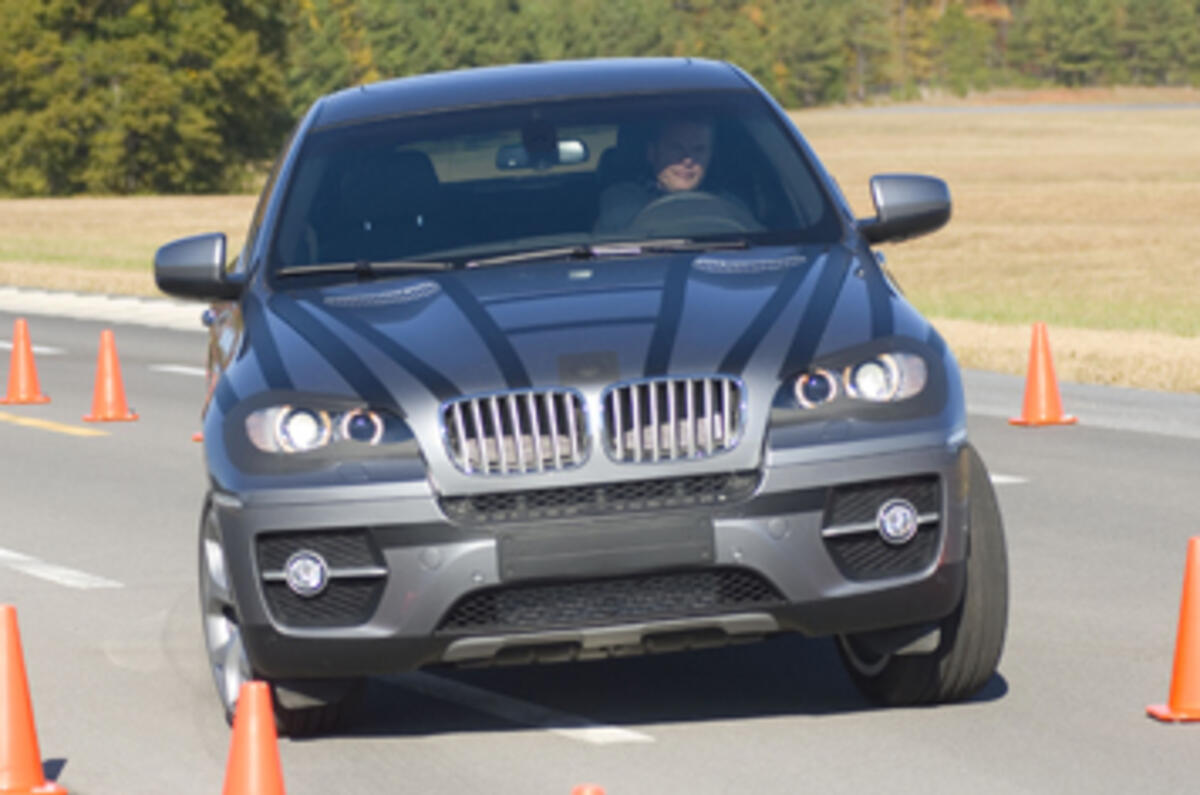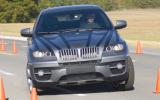What is it?
Nothing less than a whole new genre of car, according to BMW. The german car-maker refers to this, its new BMW X6, as a Sports Activity Coupe, or SAC. Others call it a crossover 4x4. And we’re the first to drive it.
Given our brief stint behind the wheel of a validation prototype on Michelin’s test track in South Carolina this week, it is clear BMW is taking a big risk with its latest model. The radical new X6 attempts to blend the inherent sportiness of an upmarket coupe with the go-anywhere ability and toughened styling of a luxury four-wheel drive. The result is a car quite unlike anything else on the road today.
It’s difficult describing the way this car looks to those who’ve never seen it in the metal. Imagine the arched roofline of a 6-series sat on the high-sided body of an X5 and you’ll begin to get some idea of what BMW has created here. It likes to refer to the car as a coupe, but with four doors and a huge one-piece liftback that opens up to reveal an enormous boot, it’s a coupe unlike any other you’ve seen.
The production version of the X6 is little changed to the concept revealed at the Frankfurt motor show back in September. The basic styling, with its taut surfacing and heavy creases, is highly reminiscent of the X5, although BMW says each body panel is unique. As with its more practical sibling, the body is a combination of steel, aluminium and plastic. No kerbweight figure has been put forward just yet, but you can bank on it being over 2000kg in base trim.
What’s new?
Photographs tend to mask the X6’s real size; it’s actually both longer and wider than an X5. Thanks to its more acutely raked windshield and shallower side glass, though, the X6's roof is around 60mm lower.
Practicality has clearly been a secondary consideration, with entry to the rear severely restricted by the intrusion of the large rear wheel arches into the door apertures, and rear seat headroom compromised by the heavy curvature of the roof. In an odd move, BMW has also decided to equip it with just four seats – a move that’s clearly aimed at separating it from the X5, which now comes with the option of a third seat row to boost its seat count to seven in total.
Based on the same four-wheel drive underpinnings as the second-generation X5, the X6 receives new driveline components that add to its dynamic prowess. Central among them is DPC (Dynamic Performance Control) – an advanced new torque vectoring system which allows the engine’s reserves to be apportioned not only between the front and rear axles dependant upon grip, but also between the individual rear wheels, in a process that is claimed to provide more neutral handling.
The idea is to direct drive to where it can be used most effectively, in an operation not dissimilar to that of a traditional locking differential on a rear-wheel-drive car. Unlike similar systems developed by its rivals, DPC operates both under load and on the overrun, meaning the X6 continues to be stabilized even when the driver steps off the throttle mid-corner.
During understeer, it automatically directs the majority of drive to the rear wheels and loads up the outside rear wheel, providing additional turning momentum beyond that generated by the steering. During oversteer, it essentially reverses the action, sending the majority of drive to the front wheels and loading the inside rear wheel.



















Join the debate
Add your comment
Re: BMW X6
Aren't we also forgetting that if customers weren't there to buy this sort of thing BMW wouldn't be building it.
I think that while it isn't the sort of thing that I would drive it is a showcase for a groundbraking bit of tech. Imagine this system on a 335xi.
Re: BMW X6
Hey, aren't we forgetting about the Subaru Forester STi ? 0 - 60 in about 4.8 seconds, over 300bhp... Lapped Anglesey circuit on Fifth Gear within 1 second of an Impreza STi. And it has a useful boot, and non-awkward entry to the rear seats, and isn't so bulky that you can't park it in town, and is low enough that you can see out of it and won't reverse over the other kiddies when dropping your darling off at school (this last comment is due to seeing a Hummer H2 manouvering outside a primary school. Terrifying. People running in all directions...).
Re: BMW X6
I actually hate this car already, without even seeing it!
Its just the anti thesis of what an 4x4 should be (good off road, and big enough to be usefull there)
One thing is, that one of the many reasons all these sheep buy Offroaders is that they need the space over a normal car....
Well, now its still a huge car, but the appropriate estate is much better! Kinda rules that out then.